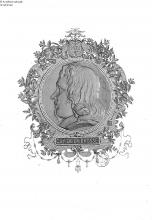
Jardin des Plantes in Paris (1636)
External links
Commentary
In 1640, the Jardin Royal des Plantes Medicinales, the 'Royal Garden of Medicinal Plants', opened to the Parisian public. The garden owes its existence to the tenacity of one man, Guy de La Brosse (1586-1641).
Since 1616, La Brosse wrote several petitions and addresses to King Louis XIII and various institutions, asking for the set up of a medical garden in Paris, modelled on the existing ones in Montpellier and Padua.
La Brosse was not a voice crying out in the desert: he was a well-connected physician, who moved in medical circles close to the King himself. His family, originating from Southern France, moved to Paris with Henri, the Protestant prince of Bourbon, as he successfully claimed the crown of France in 1589. Henri founded the Bourbon dynasty as Henry IV and converted to Catholicism; he was assassinated in 1610, leaving behind his young son Louis to rule (first under a regency and, upon coming of age, on his own).
Henry IV brought with him a southern, and mostly Protestant, medical retinue. These physicians formed a powerful faction that supported the new medical philosophy of Theophrastus von Hohenheim, called Paracelsus (1493-1541). The Paracelsian movement customarily rejected the teachings of Galen and Aristotle in favour of a new form of medicine based on empirical experience and the tenets of medical alchemy and astrology. In Paris, they encountered the resistance of the Medical Faculty of the University, which was dedicated to Galenic teaching. The conflict lead to a number of notorious confrontations that resonated throughout Europe.
La Brosse belonged to the next generation of Paracelsian physicians attached to the Court. He was promoted to physician-in-ordinary of King Louis XIII sometime in the late 1610s. In the early 1620s he dedicated himself to advancing the Medical Garden project against the continuing resistance of the Medical Faculty, which feared that it would become a Paracelsian stronghold. Finally, La Brosse obtained Louis XIII’s approval in 1626 and became the Garden's Intendant.
However, the battle was not yet won: the Garden lacked finances. To obtain them, La Brosse petitioned prominent ministers, and chiefly the powerful Cardinal de Richelieu. To advance his project he also wrote a work called On the Nature, Virtue and Utility of Plants (De la nature, vertu et utilite des plantes, 1628), which sought to reform the study of plants on a non-Galenic basis.
Finally, La Brosse succeeded: in 1633 he purchased the land for the Garden, and between 1633 and 1640 he oversaw the works to set it up. The above view in 1636 shows that most of the buildings and gardens were already finished by then. The official inauguration took place in 1640, to La Brosse's delight. He was, however, fated not to enjoy the fruits of his hard work: in 1641 he died suddenly.
After de La Brosse
The Garden de La Brosse created came to overshadow his memory. At first the physicians associated with the Garden kept to a Paracelsian framework, but as this became unfashionable, they also moved on from it. In the 18th century, the institution took a decidedly Enlightenment stance under the leadership of Georges-Louis Leclerc, Comte de Buffon (1707-1788). Buffon brought in scientists like Jean Baptiste Lamarck, author of one of the earliest theories of evolution.
In the course of the French Revolution, the Royal Garden was merged with the Cabinet of Natural Sciences (hosting the collections of the Garden) as the Museum of Natural History. The Museum grew in the 19th century to the extent that it has been called 'the Louvre of Natural Sciences'.
Today the Garden is the main botanical garden in France, covering 28 hectares of land. Since 1993, the garden, its contained buildings, archives, libraries, greenhouses, zoo and collections are classified as a national historical landmark in France.
Credits: Georgiana Hedesan (April 2022, rev Dec 2023).
Read more on Guy de La Brosse in this article.
